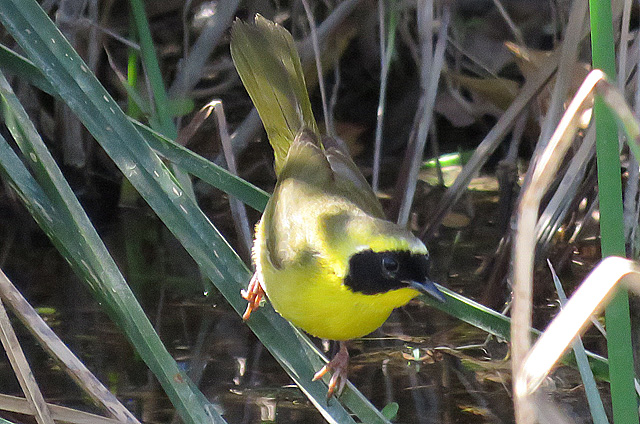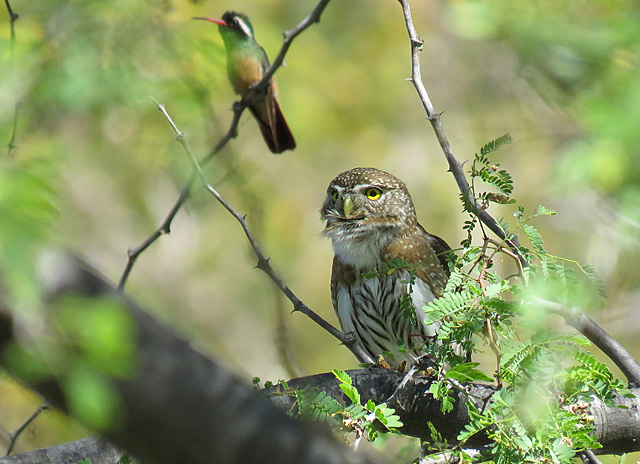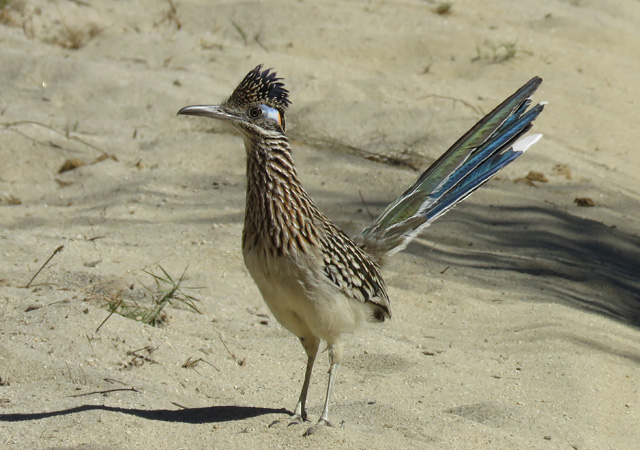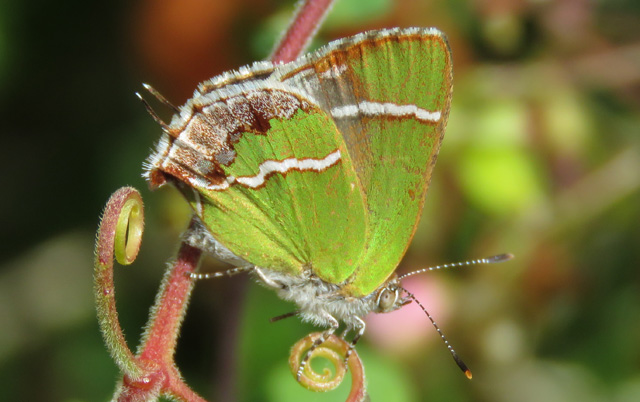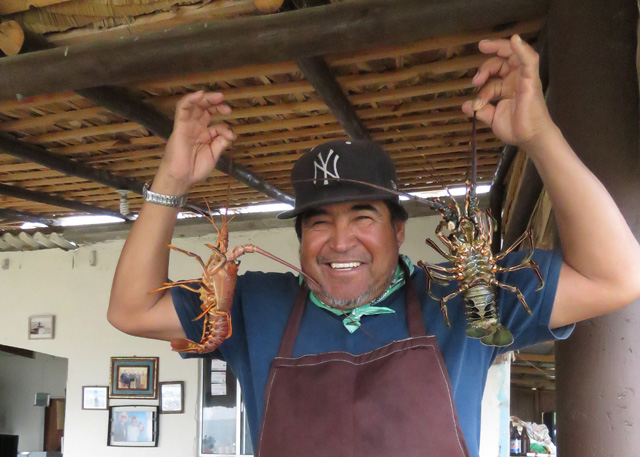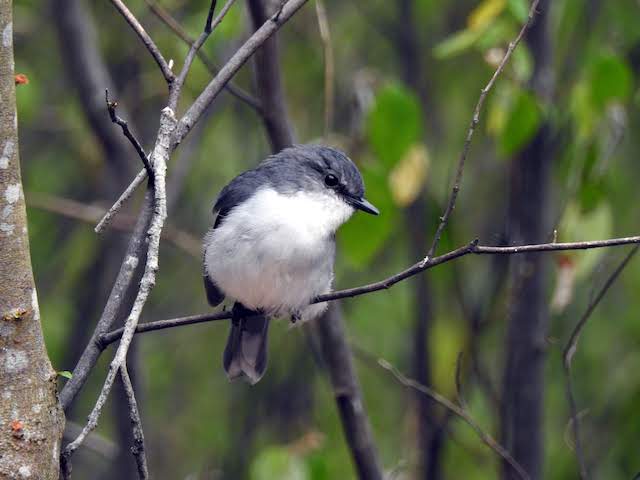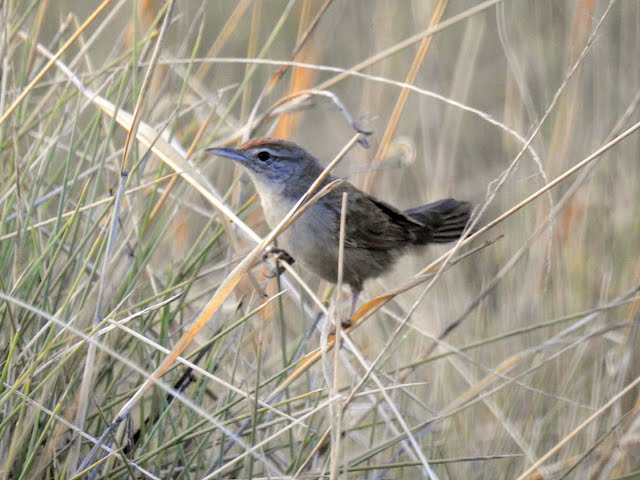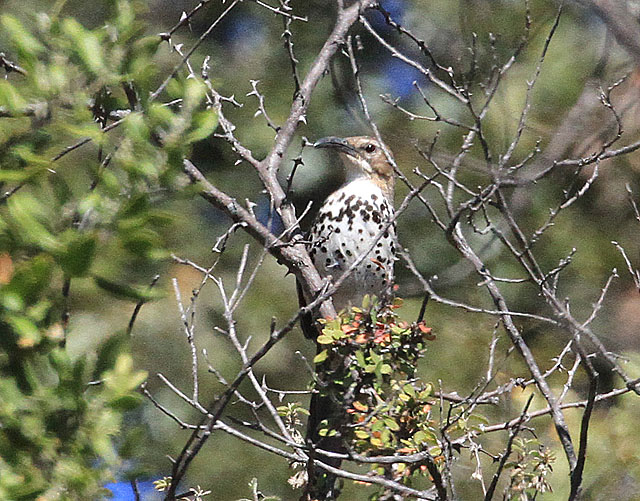From the Field
April 1:
Rich Hoyer on his Mar. 2019 tour to Baja California's Cape Region
Gorgeous weather, delicious food, amazing scenery, and a great group were highlights of this year’s Baja California tour. Belding’s Yellowthroat was one of the few serious target birds we hoped to see, and it was one of the first birds on our first morning at the San José Estuary.
Belding's Yellowthroat
Another hoped-for bird that showed well was the endemic subspecies of Northern Pygmy-Owl, which was mobbed by the endemic Xantus’s Hummingbird, providing for a very rare photo opportunity.
Northern Pygmy-Owl (Cape), Xantus's Hummingbird
Our non-endemic bird highlights were many – including an incredibly confiding and curious Greater Roadrunner that approached within a few yards of the group. A video of the bird can also be seen here: https://youtu.be/-6mniFw5mkM
Greater Roadrunner
The natural history of the Baja California peninsula is fascinating and beautiful. Rains earlier in the season had allowed for lush growth that attracted many butterflies, including this gorgeous Silver-banded Hairstreak.
Chlorostrymon simaethis sarita
One of the highlights was our whale watching boat trip on Magdalena Bay. Several whales cavorted near our boats, and one even swam right underneath us only a few feet deep.
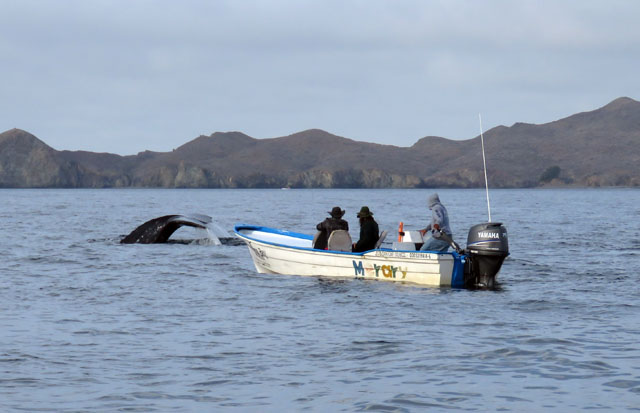
Whale Watching on Bahia Magdalena
The food everywhere was excellent, especially the perfectly fresh seafood. Here at Puerto Magdalena, the chef shows us our spiny lobster lunch that he was about to prepare, perhaps the best meal of the trip.
Lunch at Magdalena Fishing Village.JPG
March 26:
Jake Mohlmann, Evan Obercian and Ethan Kistler on their just-completed tour, Nebraska: The Sandhills and the Platte River
We just finished covering 1,000 miles of mostly paved roads through America’s Heartland. Some of the worst flooding in the history of the state was witnessed as the mighty Missouri and Platte Rivers swelled to 8 feet over flood stage leaving lots of people homeless. On top of that a rare 'Bomb Cyclone' had just passed through leaving any bits inland open water completely frozen. Despite all this the tour went on with enthusiasm as we enjoyed birds en mass all week.
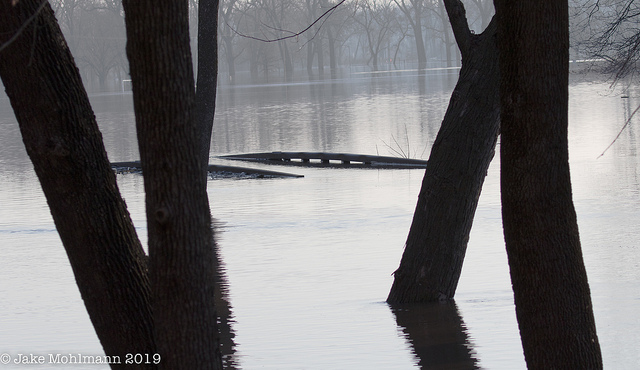
The rails of a bike path bridge show the high flood waters.
Every day we had a chance to run into several sparrow species including flocks of Tree, skulky Song, and stealthy Swamp Sparrows in the marsh vegetation. By far the highlight of the sparrow show was a very confiding Harris’s Sparrow that sat close by and sang at length for our delighted group. Also, despite most of the woods being flooded some early arrival Red-headed Woodpeckers greeted us at Fontanelle Forest.
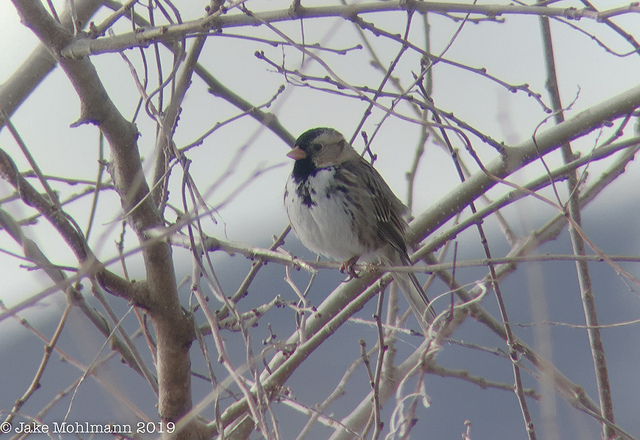
This male Harris’s Sparrow was a highlight of the tour.
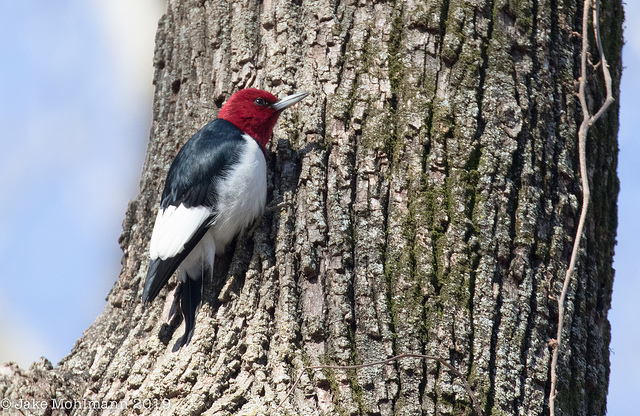
Red-headed Woodpeckers have already arrived.
Scattered throughout this region are scads of ponds and lakes which held a nice array of waterfowl with great looks at Wood Duck, Bufflehead, Common Goldeneye, and all three Merganser species. By far the most abundant fowl were the geese. Probably due to the recent weeks of plunging temperatures and lack of forage the Snow, Ross’s, Cackling, and Greater White-fronted Geese were passing over en mass and we were surprised to look up wherever we went and see hundreds pouring overhead.
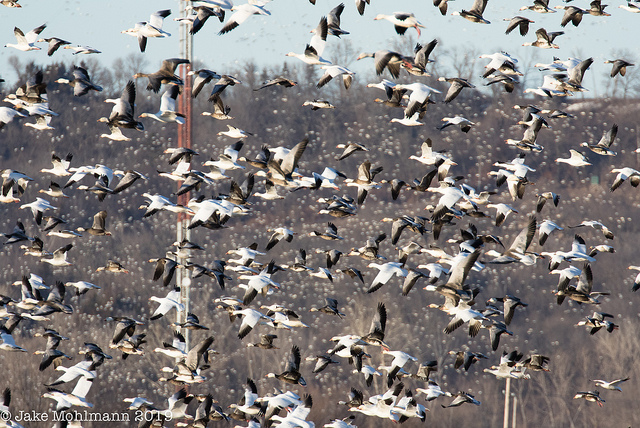
Droves of Snow Geese abound this week.
Sandhill Cranes were abundant as we watched at sunset as many of the 300,000 estimated birds came pouring in overhead landing to roost along the Central Platte River. This is truly an indescribable experience that needs to be experienced to be believed!
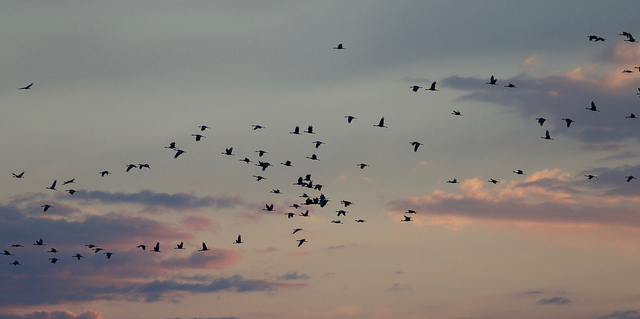
Thousands of Sandhill Cranes flyby at sunset.
Our last days led us to the famous Sandhill region of Central Nebraska, a feature that covers about ¼ of the state. Our main goal here was to view the extravagant courting rituals of Prairie Chickens and Sharp-tailed Grouse. We succeeded in capturing both of these mind-blowing phenomenon on film, at close range, from our cozy bus blind set amongst the rolling hills.
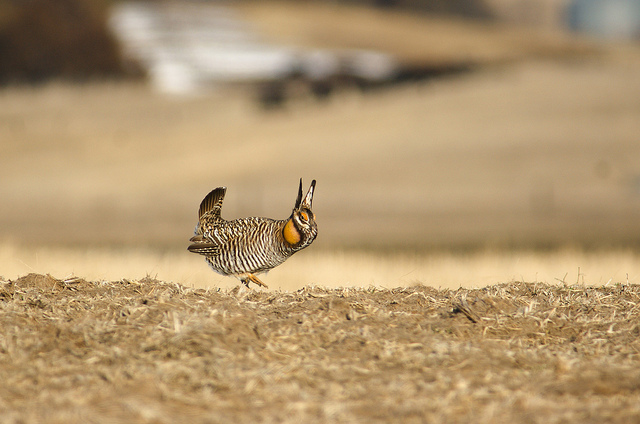
A male Greater Prairie Chicken in full display. Image: Ethan Kistler
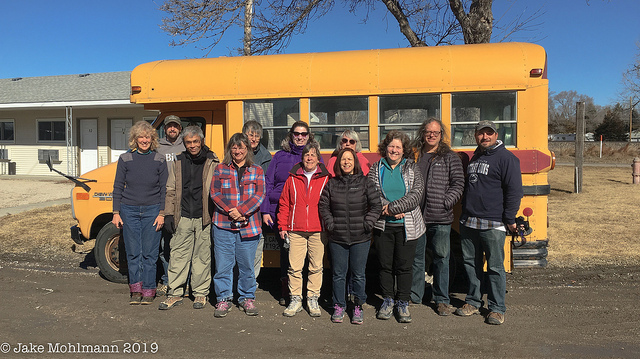
Group after witnessing Sharp-tailed Grouse displays.
March 11:
Gavin Bieber on the first of his irregular Outback Australia tours, Southwestern Australia and Northern Queensland
The first of what will be a series of irregular WINGS outback Australia tours wrapped up to critical acclaim. We began the three week journey with a fine week around the Southwest corner of the country where we located regional endemics like the...
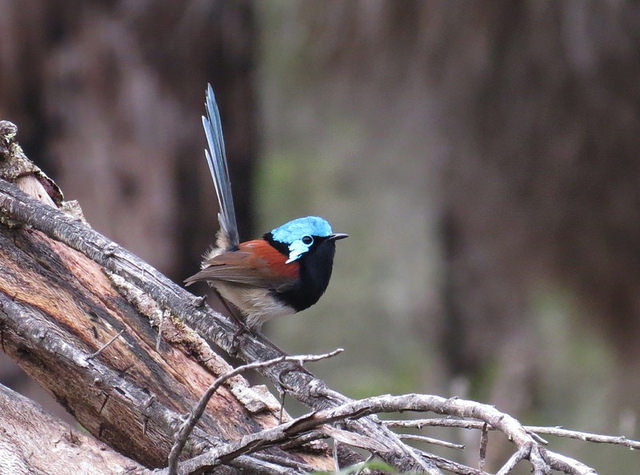
...incandescent Red-winged Fairy-Wren... (Image:Peter Taylor)
...striking White-breasted Robin... (Image: Peter Taylor)
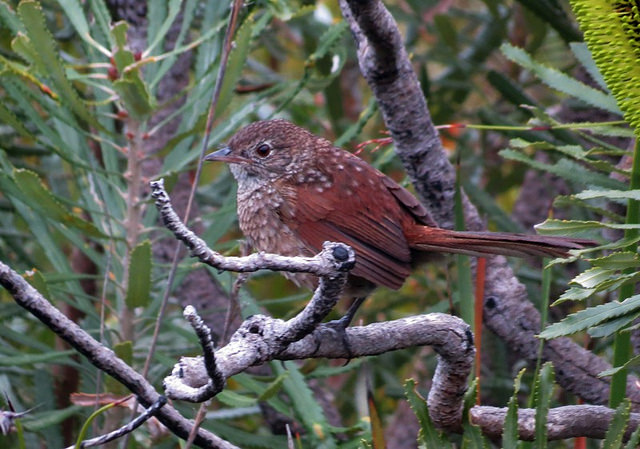
...and highly localized Western Bristlebird, here a juvenile. (Image: Peter Taylor)
We also were delighted by more widespread species such as...
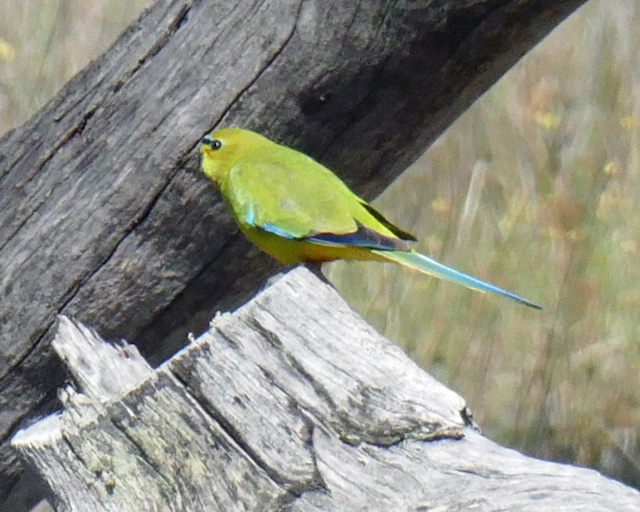
...this handsome Elegant Parrot... (Image: Bob Pease)
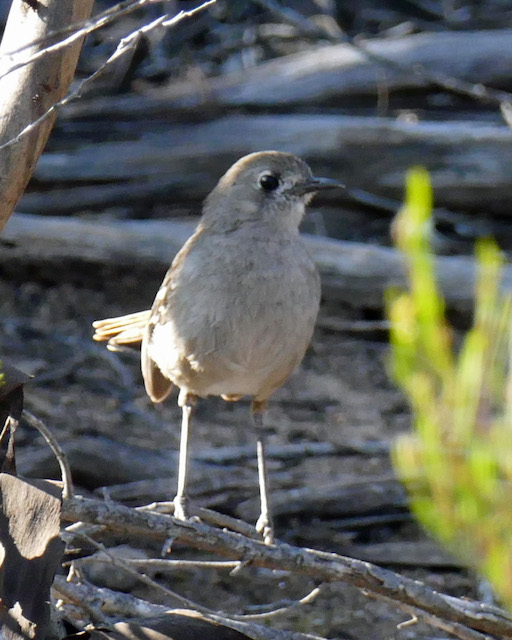
...the skulking Southern Scrub-Robin... (Image: Bob Pease)
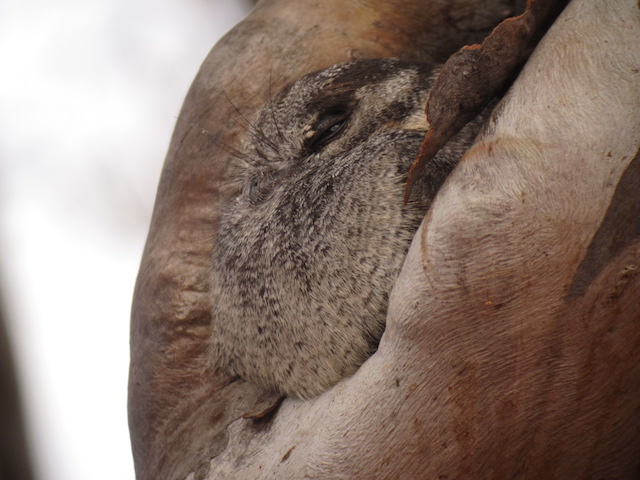
...and the undeniably cute Australian Owlet-Nightjar (Image: Bob Pease).
We then moved on to the red heart of the country amid the timeless McDonnell Ranges around Alice Springs. We found the summer heat to be intense, but not too dissimilar to that of America’s desert Southwest. Although conditions were dry, heavy rains a few months prior to our visit had brought in a wealth of irruptive species like this...
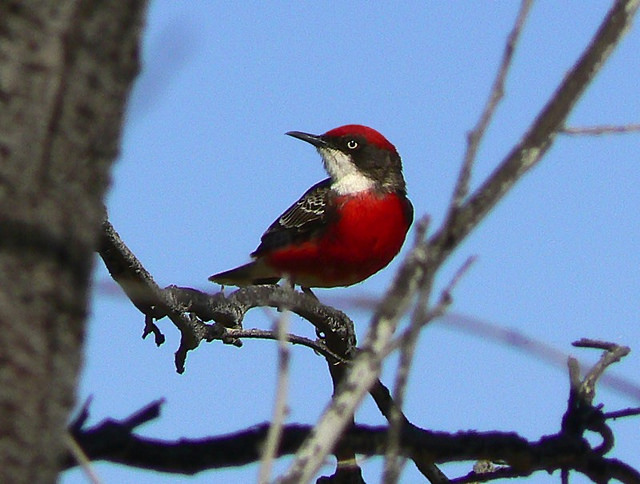
...handsome Crimson Chat... (Image: David Fisher)
...and the resident birds like...
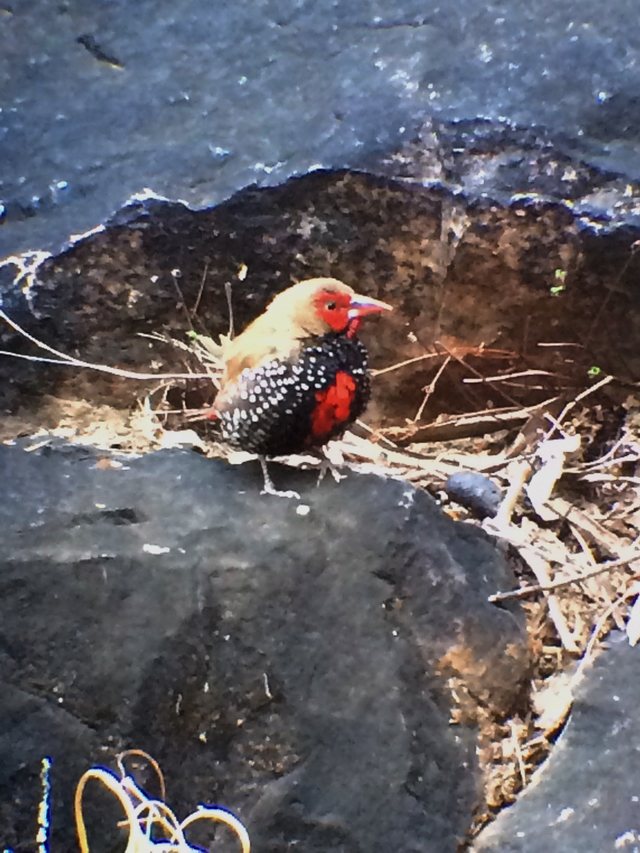
...Painted Finch... (Image: Gavin Bieber)
...
...and Spinifexbird were still in good and vocal form. (Image Ann Urlanda)
March 8:
Steve Howell and Fabrice Schmitt on their recent cruise, Around Cape Horn - Santiago, Chile to Buenos Aires, Argentina
As usual this trip was a great mix of seabirding and landbirding. From huge Wandering Albatrosses to the tiny and enigmatic Pincoya Storm-Petrel, and from magnificent Magellanic Woodpeckers to elusive tapaculos, each day produced something special. Our at-sea day south of Chacabuco was undoubtedly ‘day of the albatross,’ with six species around the ship all day...
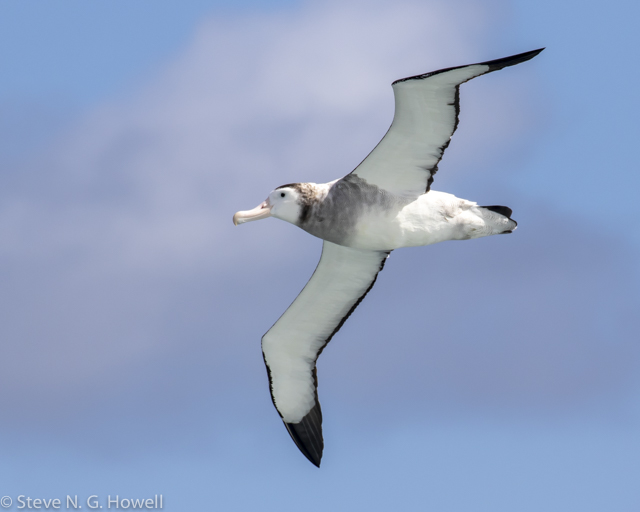
... including this female Antipodes Wandering Albatrosses sailing at eye level from Deck 15!
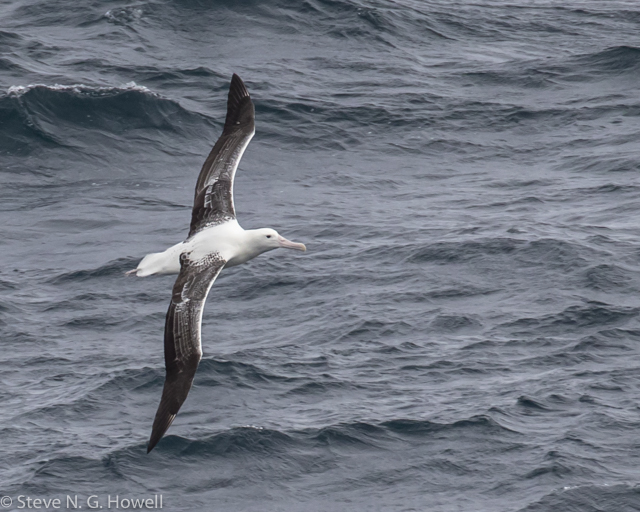
Plus both Southern (here) and Northern Royal Albatrosses regularly cruising past the bow.
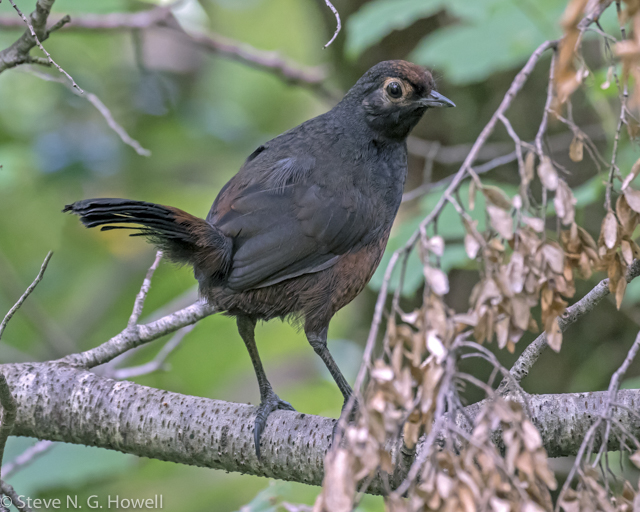
The day before we enjoyed scope views (yes, you heard correctly!) of the normally elusive Black-throated Huet-huet (pronounced wet-wet), a massive tapaculo
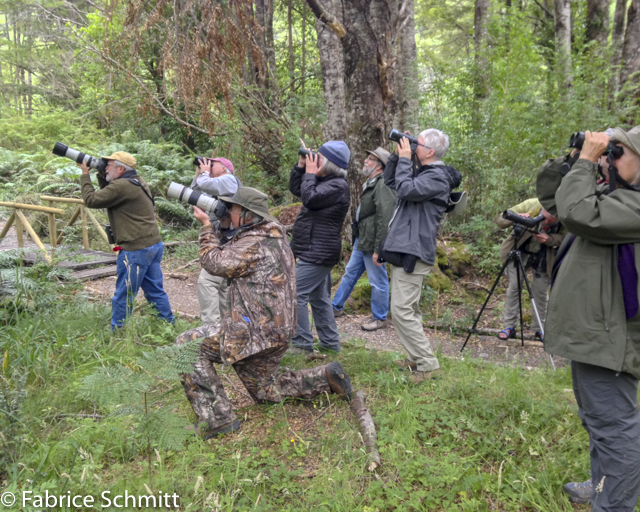
... here being stalked by the group...
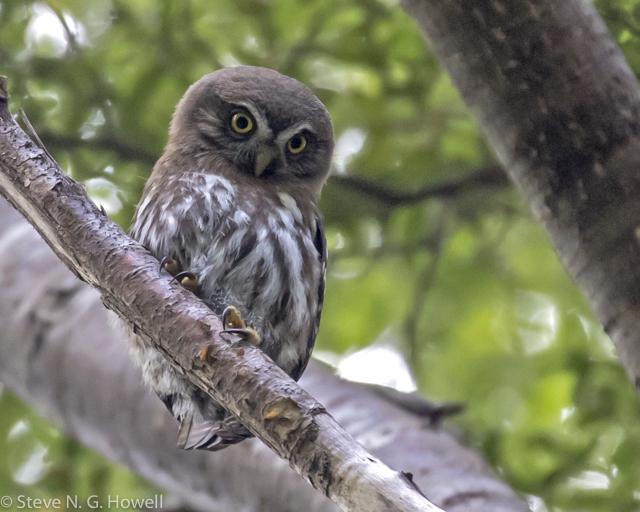
Plus an endearing young Austral Pygmy-Owl.
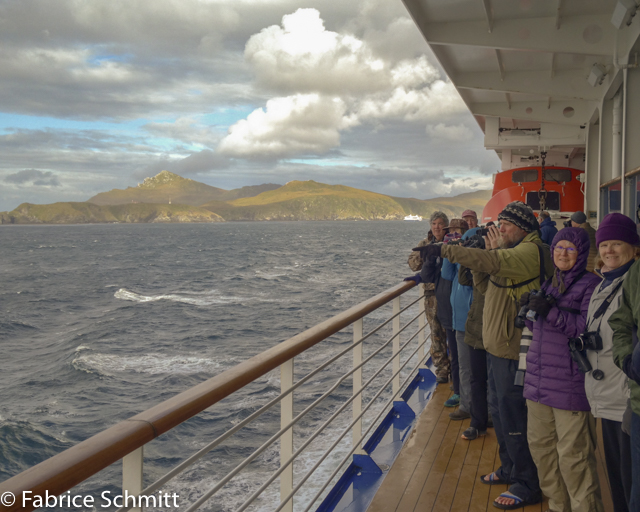
Rounding Cape Horn on a sunny but windy day, where we saw the southernmost Andean Condors sailing over ocean cliffs!

Our landing approach at the colorful Falkland Islands, where we visited the King Penguin colony and appreciated life at an island outpost.
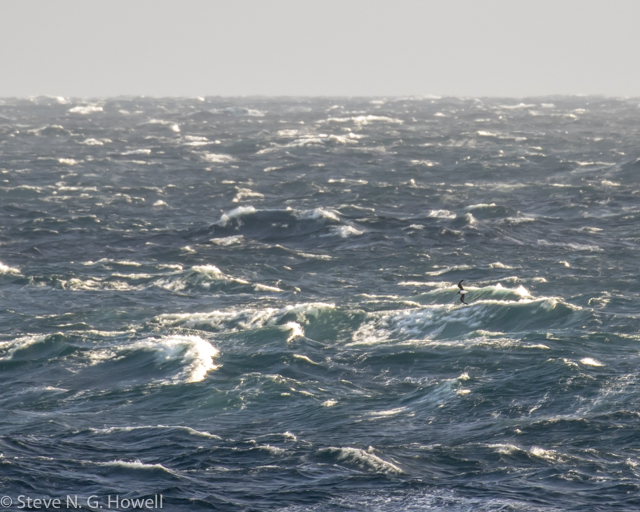
North of the Falklands, the stormy seas were coming from behind us, making for a very comfortable day of ‘unrelenting’ gadfly petrels—hundreds of Soft-plumaged and Atlantic Petrels around the ship all day. Here a Soft-plumaged Petrel ‘in habitat’ during the morning…
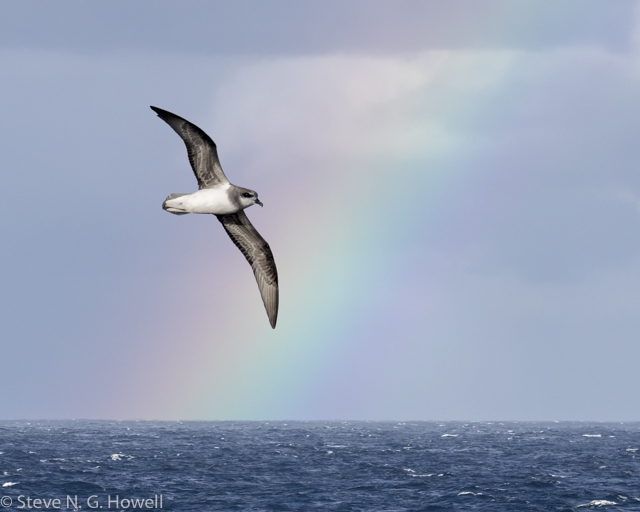
... and here another Soft-plumaged Petrel in the afternoon as the seas settled down.
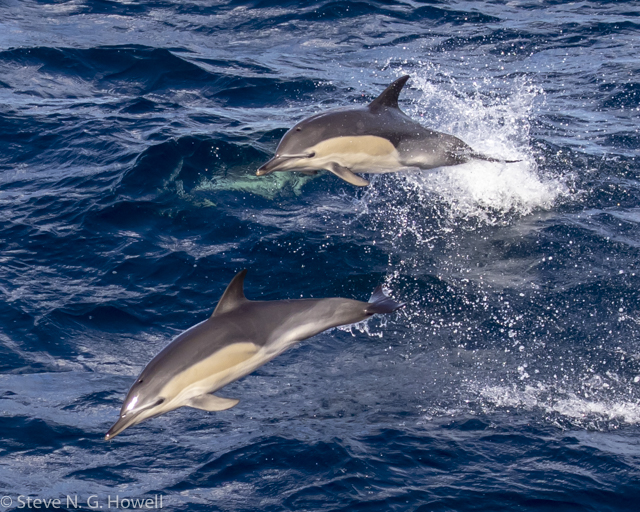
As we approached Uruguay, the sealife shifted again, with lots of Yellow-nosed Albatrosses and hundreds of Common Dolphins, marking the end of some remarkable seabirding.
February 23:
Jake Mohlmann on his and Evan Obercian's recently concluded tour, Texas: The Rio Grande Valley
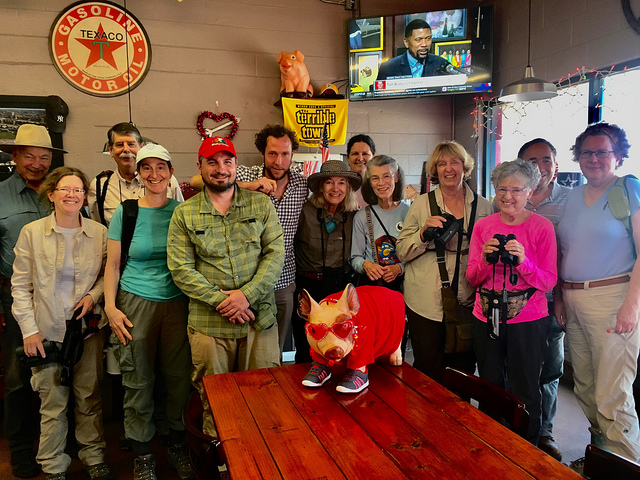
Our satiated group after a genuine Texas barbeque feast.
We just ended our latest tour through Texas's Lower Rio Grande Valley where 209 species of birds were seen around and over 1085 miles of border roads. We always hope our tour happens at a time when Mexican strays are being seen and this year didn’t disappoint. A Golden-crowned Warbler tested our bird finding abilities while a female Crimson-collared Grosbeak stole the show at Quinta Mazatlan.
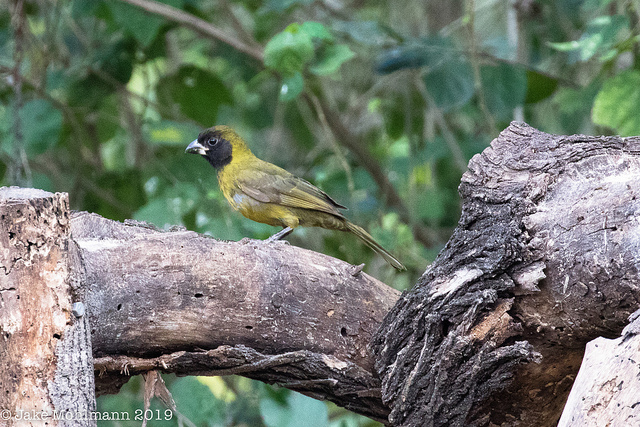
A rare Crimson-collared Grosbeak showed nicely.
Valley specialties were in abundance this year. Good numbers of Groove-billed Anis were utilizing the shrubby arroyos. We saw two at the famed Estero Llano Grande and stumbled into a particularly confiding Audubon’s Oriole in Salineño.
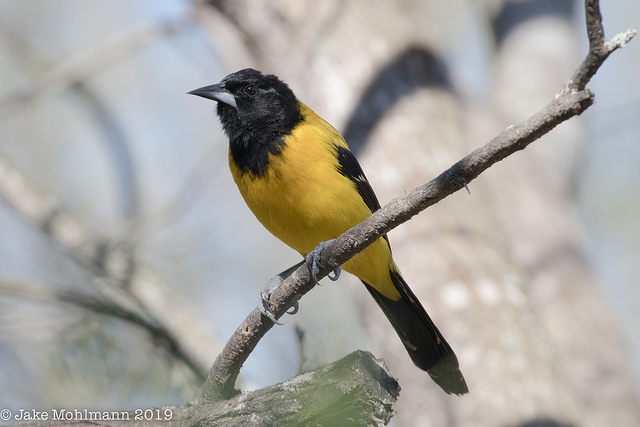
An Audubon’s Oriole came in for close inspection.
Waterfowl species numbered 23 and included such delights as thousands of Black-bellied Whistling Ducks, Ross’s Geese, and several diminutive Least Grebes.
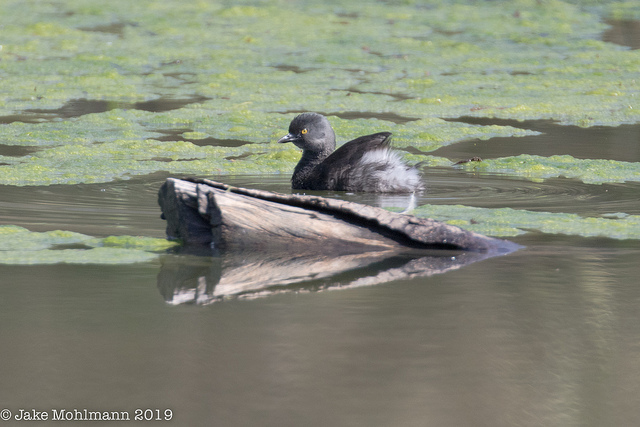
This Least Grebe was a showstopper.
We searched far and wide and found some hard to find species including LeConte’s Sparrow posing in the open, tiny Northern Beardless-Tyrannulets, a bright Yellow-throated Warbler, and a very secretive Sprague’s Pipit that finally showed well.
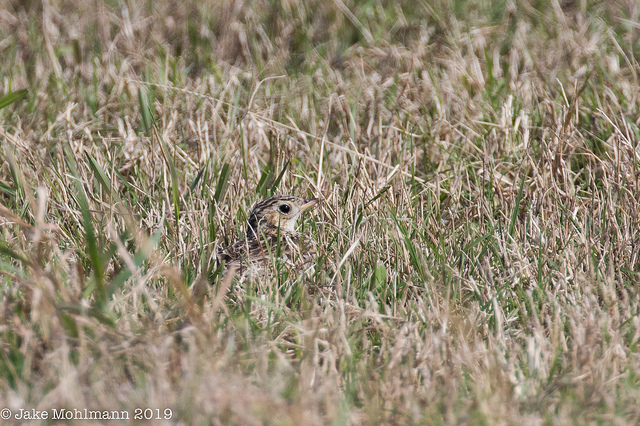
Sprague’s Pipit takes time to see but is well worth it
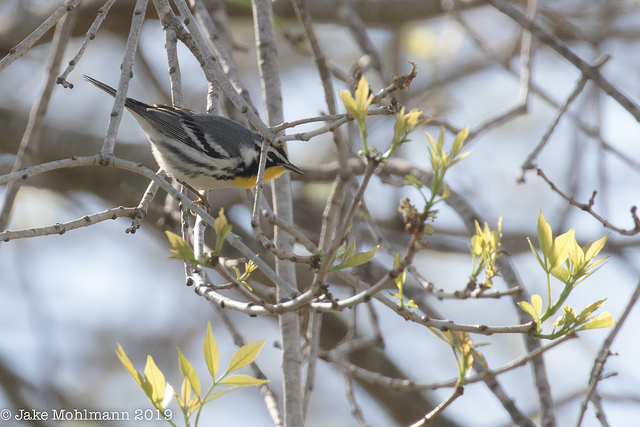
Yellow-throated Warbler in the early budding trees.

Jake upper left, LeConte's Sparrow lower right, both in focus. Surely a first... Image: Ro Carlisle
Surveying the extensive wetlands on South Padre Island is always an exciting experience. Shorebirds like Lesser and Greater Yellowlegs posed for nice comparisons, bright pink Roseate Spoonbills glowed in the waning light, and waders like Reddish Egrets and Tricolored Herons foraged in the shallows below our feet.
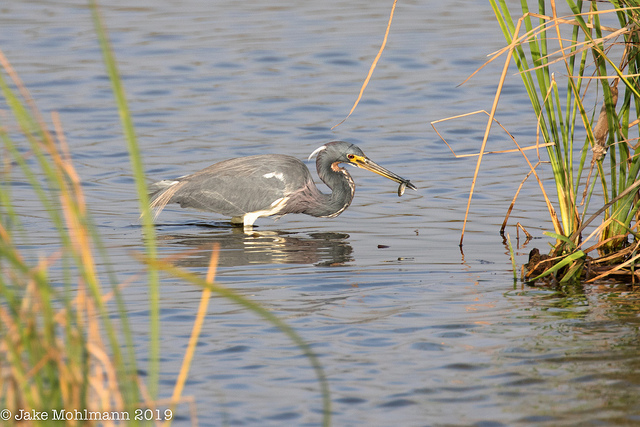
This Tricolored Heron wreaked havoc on a school of minnows.
The extension focused on seeing the endangered Whooping Cranes at Aransas National Wildlife Refuge. We witnessed a rarely seen behavior when an adult crane fed its mate a plump blue crab, and were thrilled when the boat pulled up right next to a family as they foraged for their favorite food source in the salt marsh.
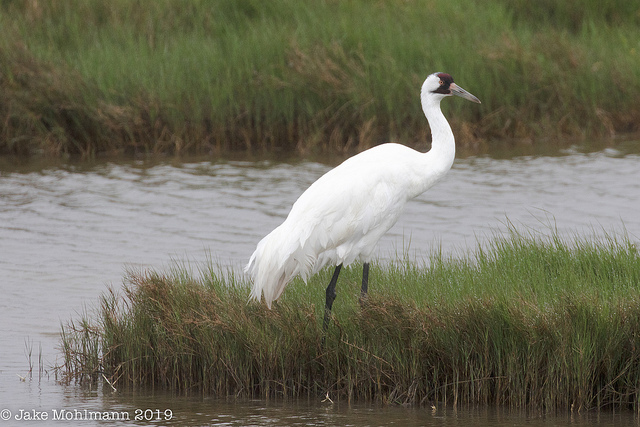
Extremely close views of the rare Whooping Crane.
February 21:
Jon Feenstra on his recently concluded tour, Ecuador: The East Slope of the Andes
We just finished a short six day tour down the Amazon slope of the Andes in northern Ecuador. The weather was mostly good, the birding was top notch, and we ate many great meals in some posh lodges. Highlights were many but most people thought that the near-simultaneous appearance of both Crested and Golden-headed Quetzals was pretty special, and our 37 species of hummingbirds was quite nice, too!
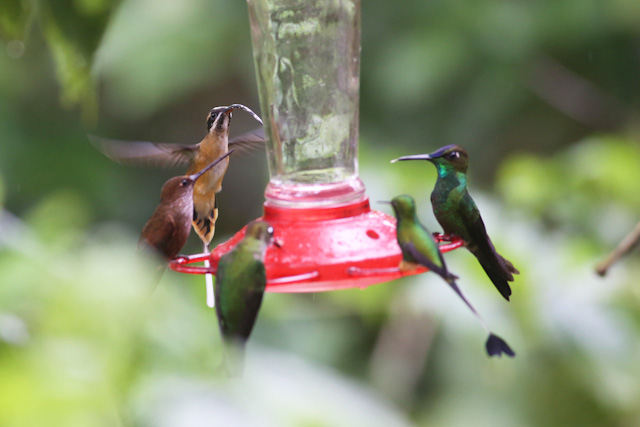
Here, five species of hummingbird visit a feeder in a poorly-veiled peace agreement.
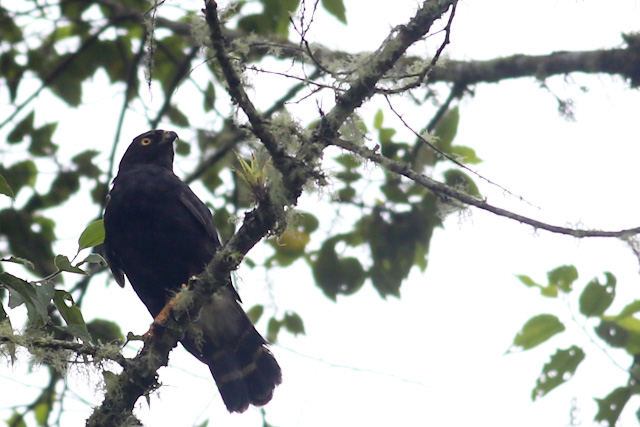
A White-rumped Hawk perches in a tree above us. Surprisingly, during the tour, we encountered three of these sharp-looking small forest hawks. A record?
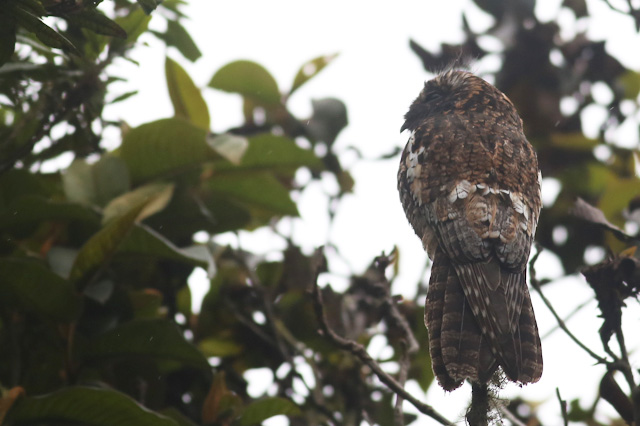
An Andean Potoo sits out on a day roost along a trail near Guango Lodge.
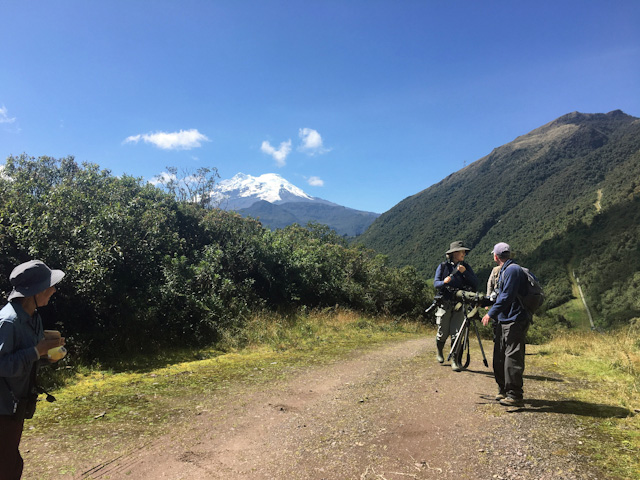
A few of the group admire Volcan Antisana. It isn't too often that a view like this happens!
February 20:
Rich Hoyer on his recently completed tour, Mexico: Oaxaca at Christmastime
This year’s Oaxaca at Christmastime tour was delightful. One day of blustery winds didn’t deter us from having great views of one of our main targets, the handsome Dwarf Jay. But then the rest of the tour had picture-perfect weather, and even in the Valle Nacional cloud forest, skies were so clear we saw Pico de Orizaba’s 18,491 foot peak from 113 miles away. We tallied a respectable 280 species, 17 of which were heard only, and there were some wonderful highlights. The bird with the most favorite votes was the Sumichrast’s Wren, and this was only the second time this tour has seen this rare, restricted, and elusive endemic. But a surprise Russet-crowned Motmot on our last morning was nearly as popular, as this gorgeous bird has the charisma thing down pat. Fulvous Owl cooperated nicely for those who came along for the picnic dinner at La Cumbre, while the pine-oak forests there were also fantastic for huge numbers of Gray Silky-flycatchers and a Gray-breasted Wood-Wren that hopped out in the open with no playback necessary. Our side trip to Tuxtepec added a huge number of species, and favorites from there included a very confiding Barred Antshrike at our breakfast spot in the foothills, a pair of stunning Crimson-collared Tanagers on the limestone forest trail, and a boldly perched Laughing Falcon that called as we watched it on our afternoon outing to the reservoir. In addition to the birds we saw several interesting lizards and plants, including some lovely orchids, and we were able to take in several ruins, visit markets, and enjoy a wonderful variety of delicious local foods in the ambience of a culture that really knows how to celebrate.
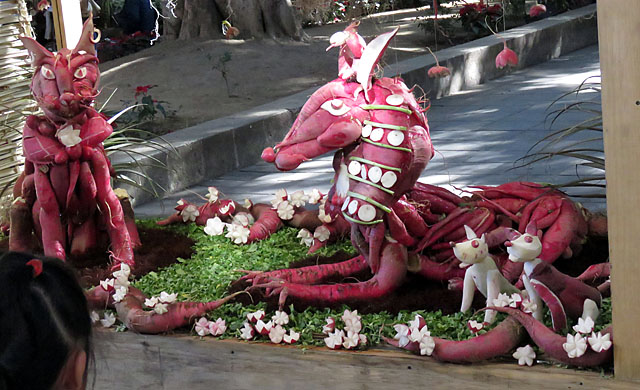
One of the most unusual cultural events we witnessed was the Noche de Rábanos, or the Night of the Radishes, a contest for the most artistic creation made solely from radishes, some of them fanciful and amazingly creative. Image: Rich Hoyer
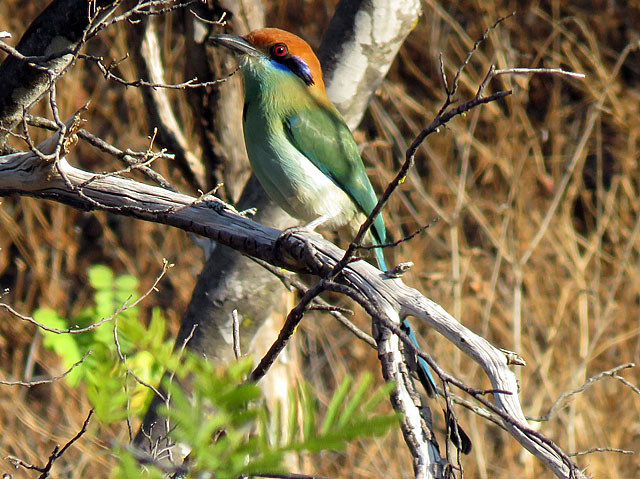
From our five mornings of birding based out of Oaxaca City, this handsome Russet-crowned Motmot received the most votes for favorite bird; this was only the second time in 16 years that we’ve seen this species. Image: Rich Hoyer
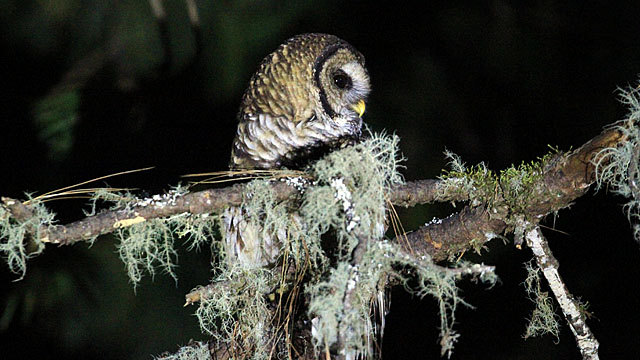
But a close second would have been this Fulvous Owl, a species unknown this side of the Isthmus of Tehuantepec until just 9 years ago. Image: Benny Baeton
Another highlight in the higher, drier parts of Oaxaca was an Ocellated Thrasher that perched up close and sang at length. Image: Benny Baeton
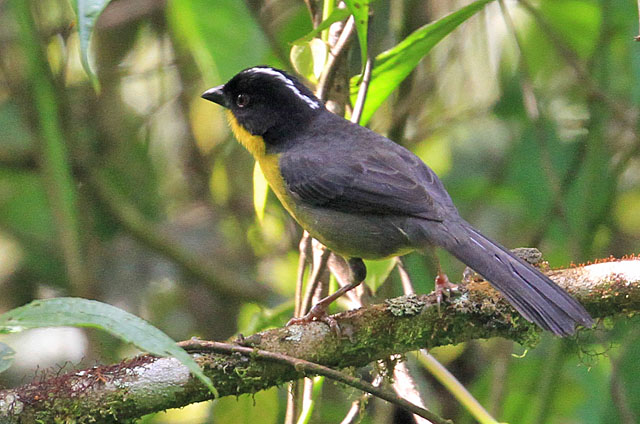
In the verdant cloud forests on the way to Tuxtepec we lucked into a pair of White-naped Brushfinches by the roadside. Image: Benny Baeton
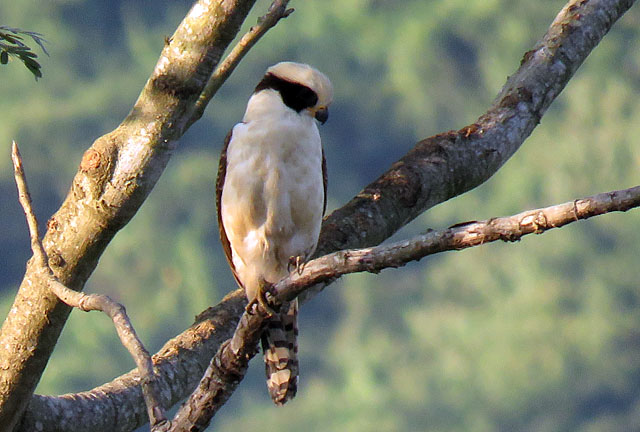
Another roadside bird spotted by our driver Rafael was this Laughing Falcon, waiting for a hapless snake to pass by. Image: Rich Hoyer
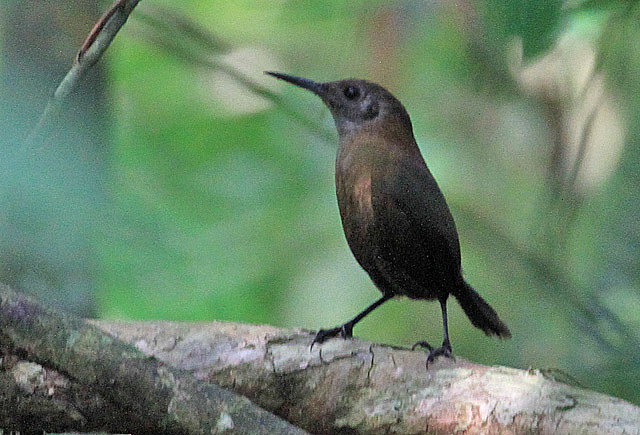
But the most exciting bird of the tour, was this Sumichrast's Wren, one of the most range-restricted species endemic to Mexico. Image: Benny Baeton
February 18:
Jon Feenstra on his recently completed tour, Ecuador: Mindo and the Northwest Andes
We're just back in Quito from a wonderful trip to the Mindo area of northwest Ecuador. We spent the week taking day trips from our forest lodge to the various elevations of cloud forest and totaled nearly 300 bird species (including 35 species of hummingbirds). The highlights were many, but here are a few that photographed well...
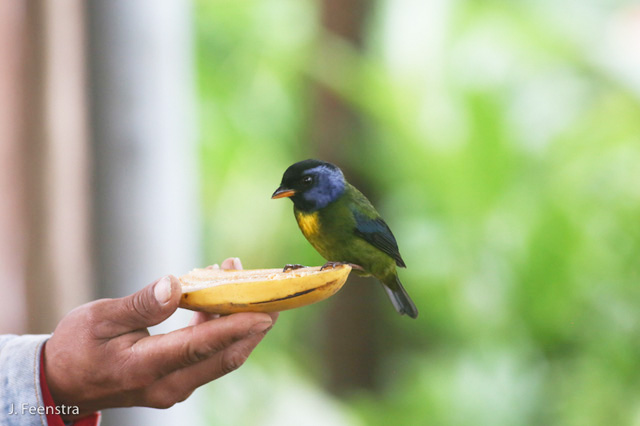
Moss-backed Tanager is a very local specialty of northwest Ecuador. We saw a few while birding the roadside in the Mashpi Conservation Area, then we saw a few more eating bananas at the Amagusa Reserve. A few of them were quite close!
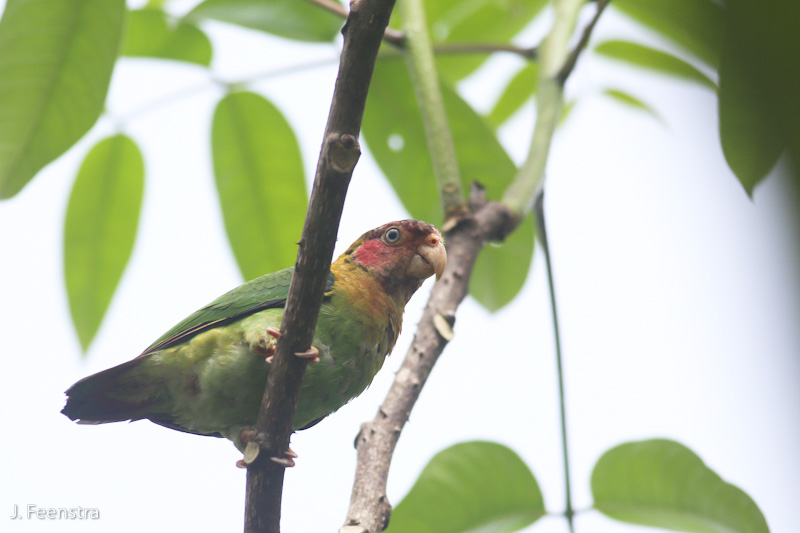 A few Rose-faced Parrots were flying around us one day, and one confidingly perched in a tree right above our heads.
A few Rose-faced Parrots were flying around us one day, and one confidingly perched in a tree right above our heads.
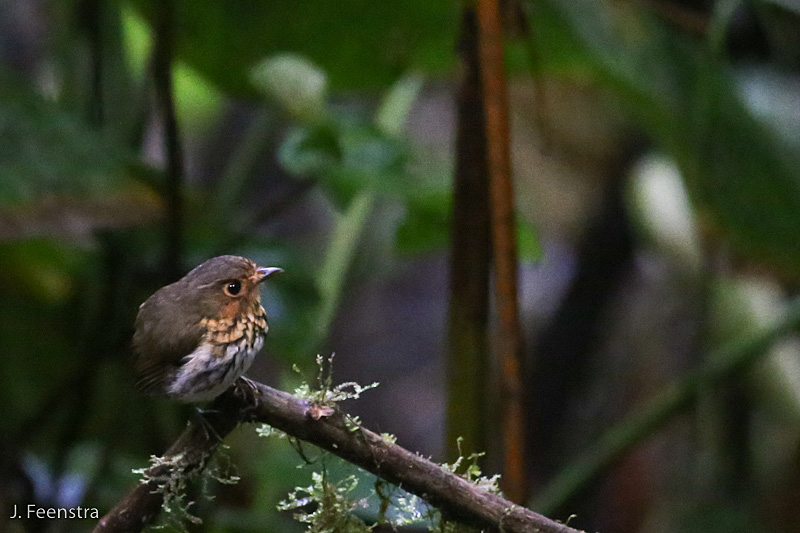 No visit to the Mindo area is complete with a visit to Reserva Paz de las Aves. This tiny Ochre-breasted Antpitta, nick-named "Shakira", was one of four species of antpitta we saw there that day.
No visit to the Mindo area is complete with a visit to Reserva Paz de las Aves. This tiny Ochre-breasted Antpitta, nick-named "Shakira", was one of four species of antpitta we saw there that day.
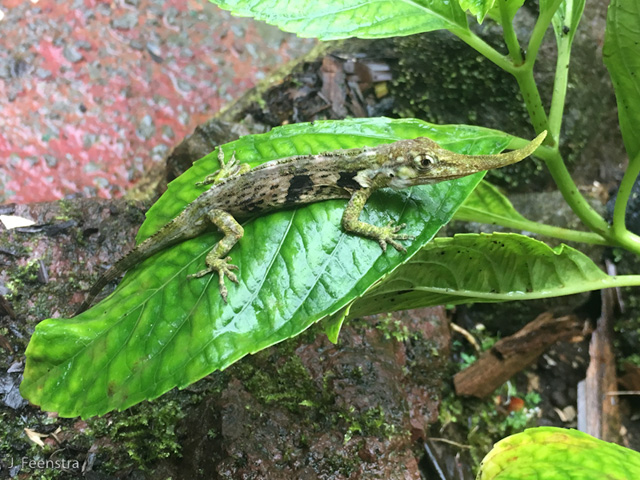
The spectacular Proboscis Anole is only known from the Mindo valley and was a real treat on the grounds of our hotel.
February 6:
Jake Mohlmann on his just-completed tour, Arizona: A Winter Week in the Southeast
In just six days we traversed 1,030 miles of cactus-studded landscapes tallying an amazing 157 species of birds. At the beginning of the tour the city of Chicago’s wind chill was -53°F, so we were all thrilled about daytime highs reaching 75° with nothing but sunshine predicted all week long. It was really hard to beat our first day’s excursion to one of the most famous birding areas in southeast Arizona. In the tree-studded Madera Canyon birds were gathering at some of the ripe hackberries. We sat in amazement as a White-throated Thrush, Arizona’s long-staying first state record, lit in one of the trees and gorged on fruit.
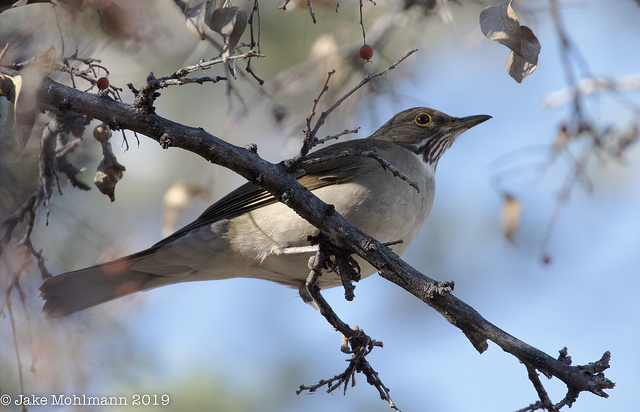
Arizona’s first state record White-throated Thrush photographed well by all
It was hard to pull ourselves away from all the excitement but we caught rumor a male Elegant Trogon was being seen upcanyon and coming in to a reliable food source. It wasn’t hard to spot all the birders lined up along the road revealing the correct place to look. As luck would have it he flew in for an extended photo session plucking berries in a flurry. It’s worth mentioning that across the street from this scene a Red-naped Sapsucker distracted us while digging wells, but more surprising was the male Painted Redstart that joined in checking the sticky traps.
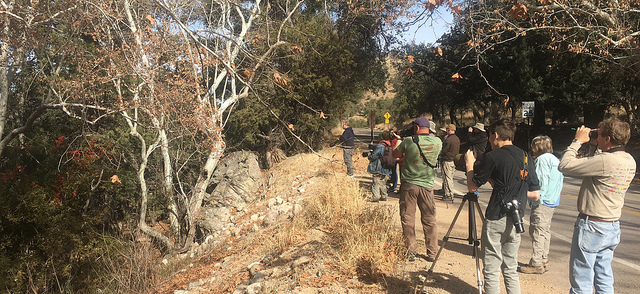
Crowds amass for a male Elegant Trogon
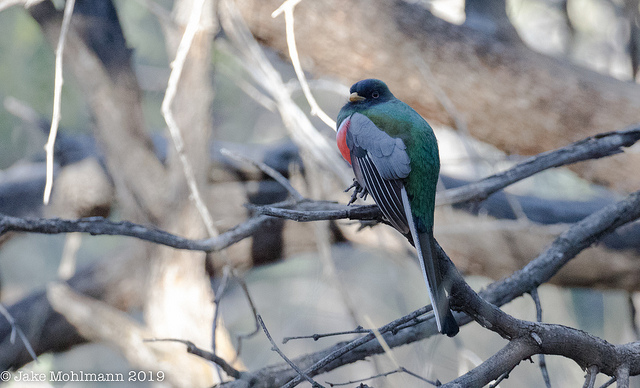
Male Elegant Trogon is always a highlight of the tour
Later this same day the group was treated to a once in a lifetime opportunity when we watched a pair of Great Horned Owls emerge early and do their best making more owls. Just after copulating a family of Harris’s Hawks weren’t impressed and decided to attack the owls, forcing them to the ground with dust flying and talons entwined. This raptor wrestle match only ended when the outnumbered owls ducked into someone’s front porch and crawled in between the flower pots.
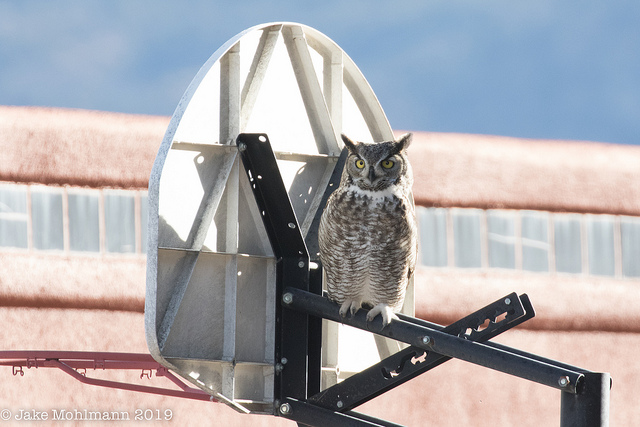
A Great Horned Owl, pre tussle
The Tucson Valley Christmas Bird Count tallies the highest number of wintering Vermilion Flycatchers in the country, of which we saw several. There is nothing like seeing these birds sit atop a perch and turn anything into a flaming candle.
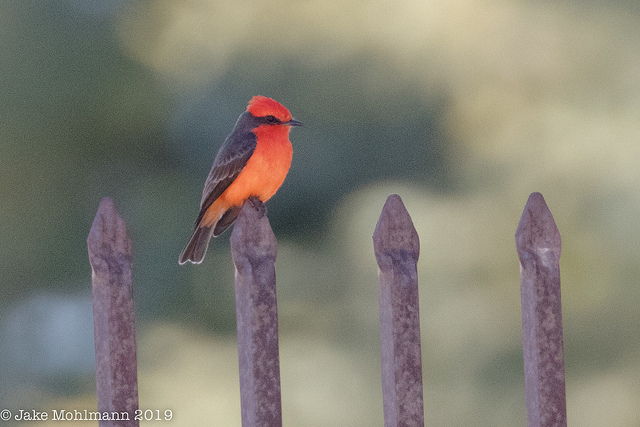
A male Vermilion Flycatcher lights up a fence post
We visited many canyons throughout the week including Box, Carr, and perhaps the most scenic of all Cave Creek Canyon. The Cave Creek Ranch feeders were ripe with birds this year with barely any room at the feeders for the excess. Blue-throated Hummingbirds drank from feeders, Golden-crowned and ‘Red’ Fox sparrow fed in the dirt, and an optimistic Sharp-shinned Hawk eventually flew in to steal the show. The only sound left was the cascading sound of the Canyon Wren’s song echoing off the rock walls nearby.
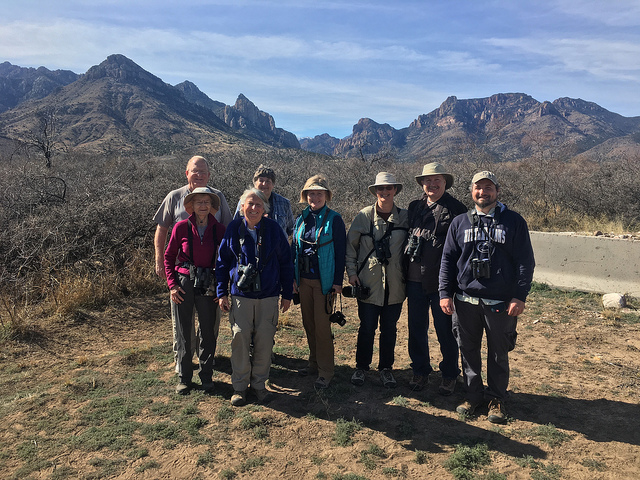
Our group excited to explore scenic Cave Creek Canyon
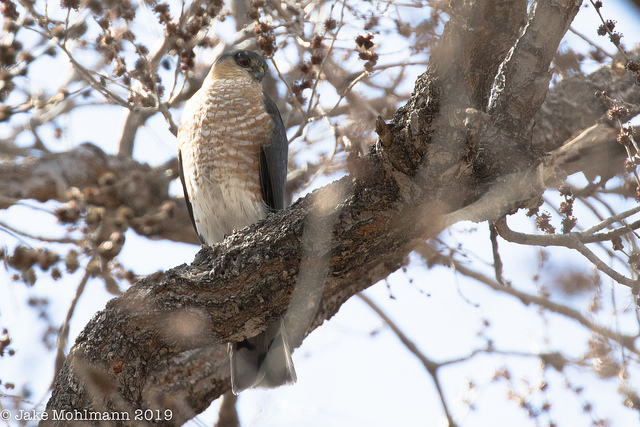
Birds scatter when a Sharp-shinned Hawk arrives
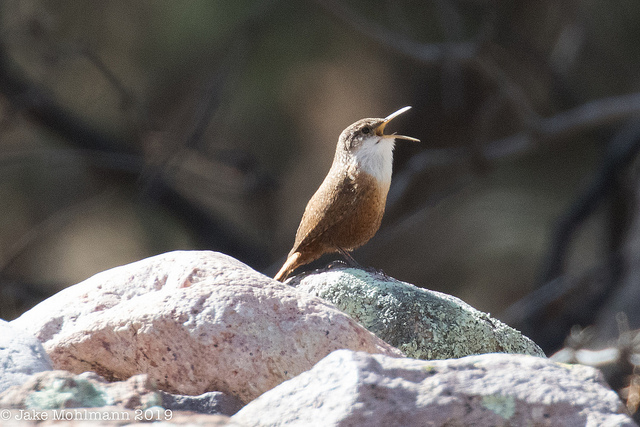
We watched as the Canyon Wren belted out its unforgettable song
In some years eastern warblers are encountered and this year was no exception. The best views one could ask of a wintering Louisiana Waterthrush along the San Pedro River was a highlight for many on the tour, including those whose nemesis bird this was from the east coast.
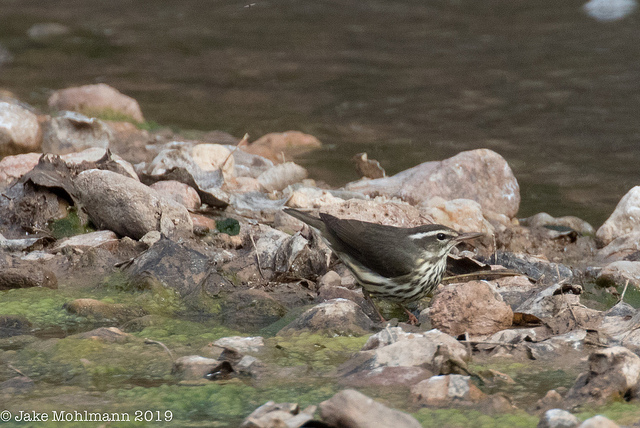
This Louisiana Waterthrush was a lifer for most
No tour would be complete without a stroll around the famed Sweetwater Wetlands. This complex is perfectly placed along the Santa Cruz River and attracts lots of birds including some of the rarer marsh species. It didn’t take long for us to find a perfectly still American Bittern blending in perfectly with the vertical dead reeds. Even more of a surprise was the Least Bittern that MaryAnn somehow spotted near the top of the vegetation secretly surveying the scene.
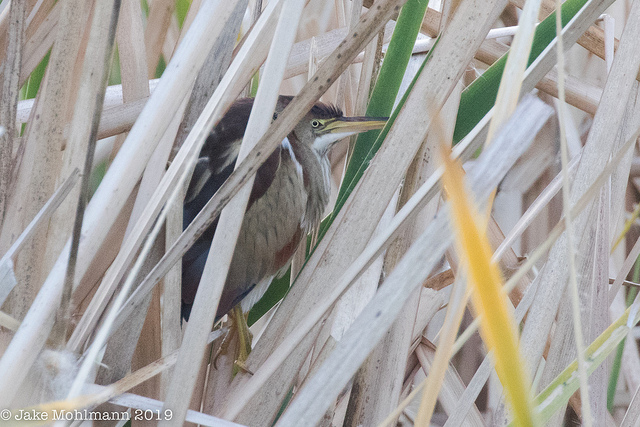
A tiny Least Bittern crept into view for 5 minutes
January 16:
Steve Howell on his just-completed tour, Mexico: San Blas
Steve Howell reports from the conclusion of another wonderful week in San Blas where the birds kept them busy, but in a relaxed way based at a very comfortable hotel with excellent food and hospitality, plus warm and sunny weather all week. Ahh, Mexico…
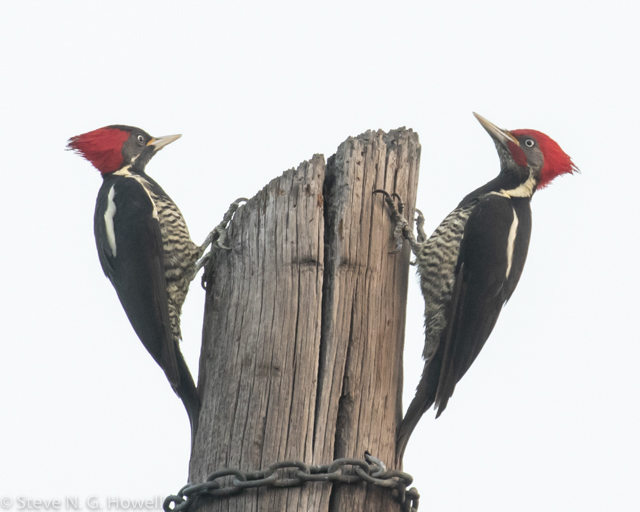
The first morning, this pair of Lineated Woodpeckers posed on a pole right outside our hotel!
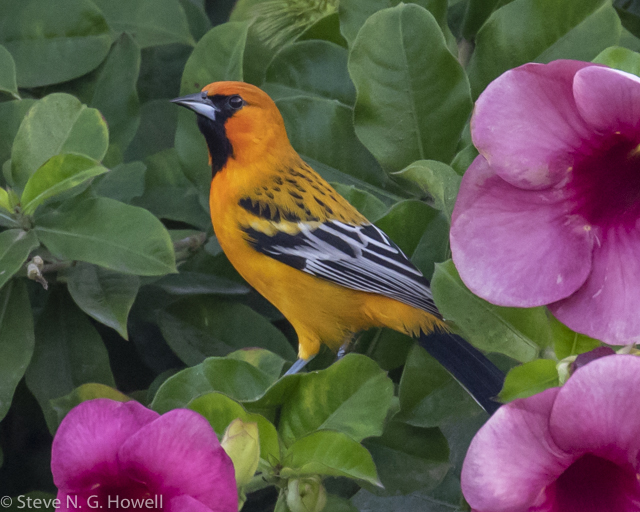
Followed within a block by this stunning male Streak-backed Oriole.
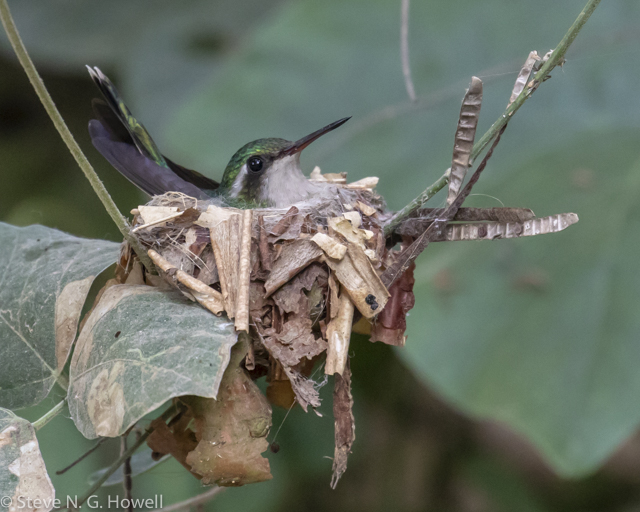
The next morning this tiny female Golden-crowned Emerald sat on her nest right beside a dirt road.
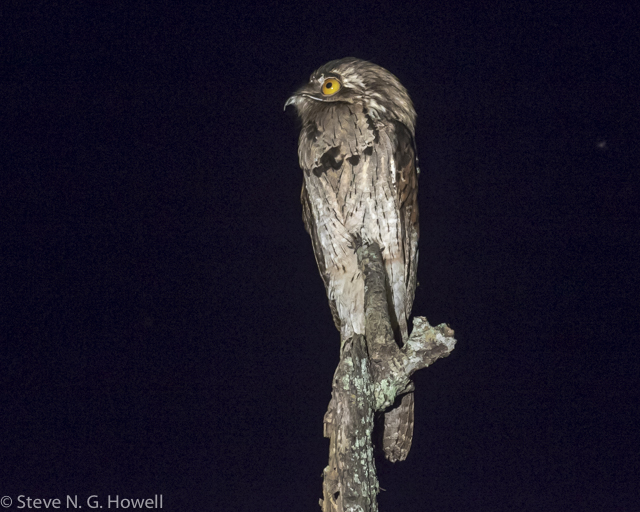
Always popular, Northern Potoos showed exceptionally well on our nocturnal boat ride.
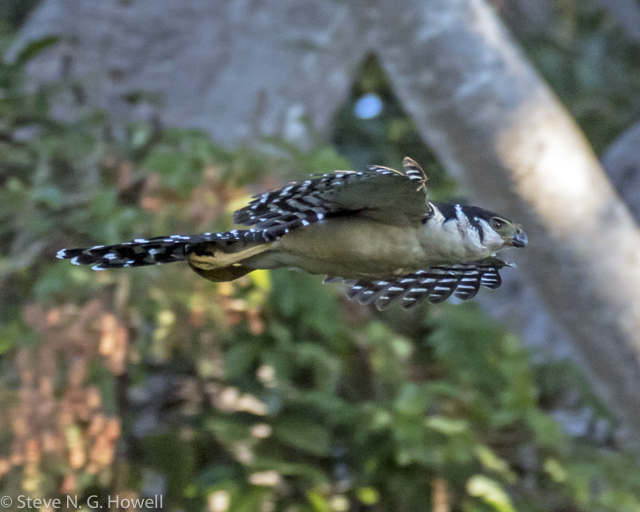
Collared Forest-Falcon usually shows itself somewhere during the week, this time on the last morning—but what a view!
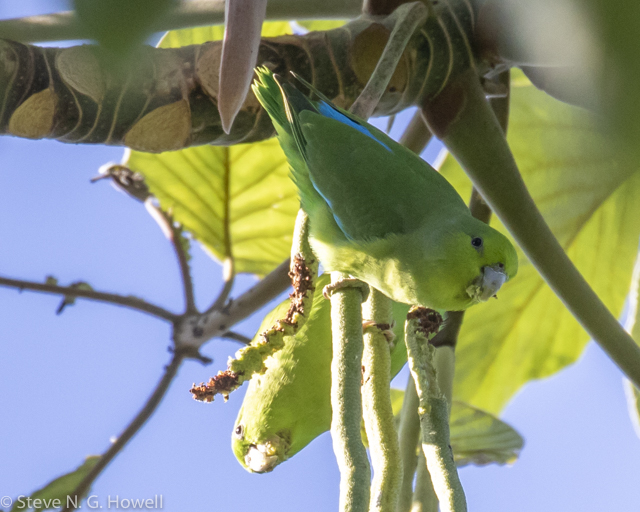
Among many other highlights, these diminutive Mexican Parrotlets posed for photos, but all too soon the week was gone.

